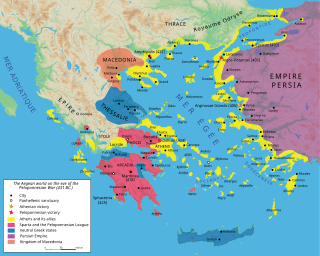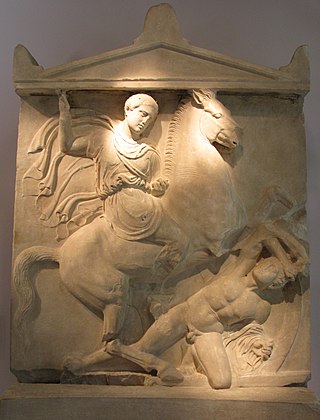
Amyntas III was king of the ancient Greek kingdom of Macedonia from 393/2 to 388/7 BC and again from 387/6 to 370 BC. He was a member of the Argead dynasty through his father Arrhidaeus, a son of Amyntas, one of the sons of Alexander I. His most famous son is Philip II, father of Alexander the Great.

The Peloponnesian League was an alliance of ancient Greek city-states, dominated by Sparta and centred on the Peloponnese, which lasted from c.550 to 366 BC. It is known mainly for being one of the two rivals in the Peloponnesian War, against the Delian League, which was dominated by Athens.
This article concerns the period 389 BC – 380 BC.

Philip II of Macedon was the king (basileus) of the ancient kingdom of Macedonia from 359 BC until his death in 336 BC. He was a member of the Argead dynasty, founders of the ancient kingdom, and the father of Alexander the Great.

The King's Peace was a peace treaty guaranteed by the Persian King Artaxerxes II that ended the Corinthian War in ancient Greece. The treaty is also known as the Peace of Antalcidas, after Antalcidas, the Spartan diplomat who traveled to Susa to negotiate the terms of the treaty with the king of Achaemenid Persia. The treaty was more commonly known in antiquity, however, as the King's Peace, a name that reflects the depth of Persian influence in the treaty, as Persian gold had driven the preceding war. The treaty was a form of Common Peace, similar to the Thirty Years' Peace which ended the First Peloponnesian War.

The Battle of Leuctra was fought on 6 July 371 BC between the Boeotians led by the Thebans, and the Spartans along with their allies amidst the post–Corinthian War conflict. The battle took place in the vicinity of Leuctra, a village in Boeotia in the territory of Thespiae. The Theban victory shattered Sparta's immense influence over the Greek peninsula, which Sparta had gained with its victory in the Peloponnesian War a generation earlier.

Perdiccas II was the king of Macedonia from 454 BC until his death in 413 BC. During the Peloponnesian War, he frequently switched sides between Sparta and Athens.

Olynthus is an ancient city in present-day Chalcidice, Greece. It was built mostly on two flat-topped hills 30–40m in height, in a fertile plain at the head of the Gulf of Torone, near the neck of the peninsula of Pallene, about 2.5 kilometers from the sea, and about 60 stadia from Poteidaea.

The Corinthian War was a conflict in ancient Greece which pitted Sparta against a coalition of city-states comprising Thebes, Athens, Corinth and Argos, backed by the Achaemenid Empire. The war was caused by dissatisfaction with Spartan imperialism in the aftermath of the Peloponnesian War, both from Athens, the defeated side in that conflict, and from Sparta's former allies, Corinth and Thebes, who had not been properly rewarded. Taking advantage of the fact that the Spartan king Agesilaus II was away campaigning in Asia against the Achaemenid Empire, Thebes, Athens, Corinth and Argos forged an alliance in 395 BC with the goal of ending Spartan hegemony over Greece; the allies' war council was located in Corinth, which gave its name to the war. By the end of the conflict, the allies had failed to end Spartan hegemony over Greece, although Sparta was durably weakened by the war.

The Battle of Mantinea was fought on 4 July 362 BC between the Thebans, led by Epaminondas and supported by the Arcadians, Argives, Messenians, Thessalians, and the Boeotian league against the Spartans, led by King Agesilaus II and supported by the Eleans, Athenians, Euboeans, and Mantineans. The battle was to determine which of the two alliances would dominate Greece. However, the death of Epaminondas and his intended successors would cost Thebes the military leadership and initiative to maintain Theban supremacy in the region. Similarly, the Spartans were weakened by yet another defeat and loss of troops. Epaminondas' death coupled with the impact on the Spartans of yet another defeat weakened both alliances, and paved the way for Macedonian conquest led by Philip II of Macedon.

Teleutias was the brother of the Spartan king Agesilaus II, and a Spartan naval commander in the Corinthian War. He first saw action in the campaign to regain control of the Corinthian Gulf after the Spartan naval disaster at Cnidus in 394 BC, and was later active in the Spartan campaign against Argos in 391 BC. Later that year, he was dispatched to the Aegean to take command of a Spartan fleet harassing Rhodes. Once in command, he attacked and seized a small Athenian fleet sailing to aid Evagoras I of Salamis, Cyprus, then settled in to attack Rhodes with his newly augmented fleet.

The Second Athenian League was a maritime confederation of Greek city-states that existed from 378 to 355 BC under the leadership (hegemony) of Athens. The alliance represented a partial revival of the Delian League, which had been disbanded in 404 BC following the defeat of Athens in the Peloponnesian War. The new League was centered in the Aegean and included over 60 states, among which were Kos, Mytilene, Rhodes, and Byzantium. It was primarily formed as a defensive alliance against Sparta and secondly the Persian Empire. The new League's main objective was to preserve peace in Greece and counterbalance Sparta's growing hegemony and aggression. The League largely revived Athenian influence in the Greek world, reestablishing it as the strongest naval power in the eastern Mediterranean. This time, Athens made conscious efforts to avoid the strict terms that had eventually rendered the previous Delian League unpopular. The alliance lasted until 355 BC, when most of the allied cities became independent following the Social War that broke out in 357 BC.
Eudamidas I was Spartan king between 331 and c. 300 BC. He succeeded his brother Agis III, who died at the battle of Megalopolis against Macedonia. Eudamidas' reign was therefore peaceful as Sparta recovered from this disaster. He even refused to join the other Greek states in the Lamian War in 323, and was later noted for his interest in philosophy—peculiar for a Spartan king.

Classical Greece was a period of around 200 years in Ancient Greece, marked by much of the eastern Aegean and northern regions of Greek culture gaining increased autonomy from the Persian Empire; the peak flourishing of democratic Athens; the First and Second Peloponnesian Wars; the Spartan and then Theban hegemonies; and the expansion of Macedonia under Philip II. Much of the early defining mathematics, science, artistic thought, theatre, literature, philosophy, and politics of Western civilization derives from this period of Greek history, which had a powerful influence on the later Roman Empire. Part of the broader era of classical antiquity, the classical Greek era ended after Philip II's unification of most of the Greek world against the common enemy of the Persian Empire, which was conquered within 13 years during the wars of Alexander the Great, Philip's son.

The Chalcidian League, also referred to as the Olynthians or the Chalcidians in Thrace to distinguish them from the Chalcidians in Euboea, was a federal state that existed on the Chalcidice peninsula, on the shores of the northwest Aegean Sea, from around 430 BCE until it was destroyed by Philip II of Macedon in 348 BCE.
Bottiaeans or Bottiaei were an ancient people of uncertain origin, living in Central Macedonia. Sometime, during the Archaic period, they were expelled by Macedonians from Bottiaea to Bottike. During the Classical era, they played an active role in the military history of ancient Chalcidice, but after the Macedonian conquest under Philip II nothing remained except the names of these two regions and the adjective Bottiaean, which was limited to sole geographical meaning. Unlike other tribes of Macedonia ruled by kings or living in villages, Bottiaeans developed some polis form of self-government. Unfortunately, no Bottiaean individual is known to us and the limited historical or archaeological sources shed no further light.

Under the reign of Philip II, the ancient kingdom of Macedonia, initially at the periphery of classical Greek affairs, came to dominate Ancient Greece in the span of just 25 years, largely thanks to the character and policies of its king. In addition to utilising effective diplomacy and marriage alliances to achieve his political aims, Philip II was responsible for reforming the ancient Macedonian army into an effective fighting force. The Macedonian phalanx became the hallmark of the Macedonian army during his reign and the subsequent Hellenistic period. His army and engineers also made extensive use of siege engines. Chief among Philip's Thracian enemies was the ruler Kersebleptes, who may have coordinated a temporary alliance with Athens. In a series of campaigns stretching from 356 to 340 BC, Philip II managed to ultimately subjugate Kersebleptes as a tributary vassal, conquering much of Thrace in the process. Philip II also fought against the Illyrian king Bardylis, who threatened Macedonia proper, and against Grabos II and Pleuratus in Illyria. In his newly conquered territories, he founded new cities such as Philippi, Philippopolis, Herakleia Sintike, and Herakleia Lynkestis.
One column containing two treaties between Amyntas III of Macedon and the Chalkidian League has been discovered at Olynthus. The first treaty is dated in c. 393 BC, the second one before 382 BC. The language of the texts is Ionic Greek, the main dialect of Chalcidice.

The Theban–Spartan War of 378–362 BC was a series of military conflicts fought between Sparta and Thebes for hegemony over Greece. Sparta had emerged victorious from the Peloponnesian War against Athens, and occupied an hegemonic position over Greece. However, the Spartans' violent interventionism upset their former allies, especially Thebes and Corinth. The resulting Corinthian War ended with a difficult Spartan victory, but the Boeotian League headed by Thebes was also disbanded.
Derdas II was the ruler of the region of Elimiotis (Ἐλιμιώτις), also rendered as Elymia (Ἐλιμία) and Elimeia (Ἐλίμεια), in the early 4th century BCE. Elimiotis was a client state of Macedon.

















